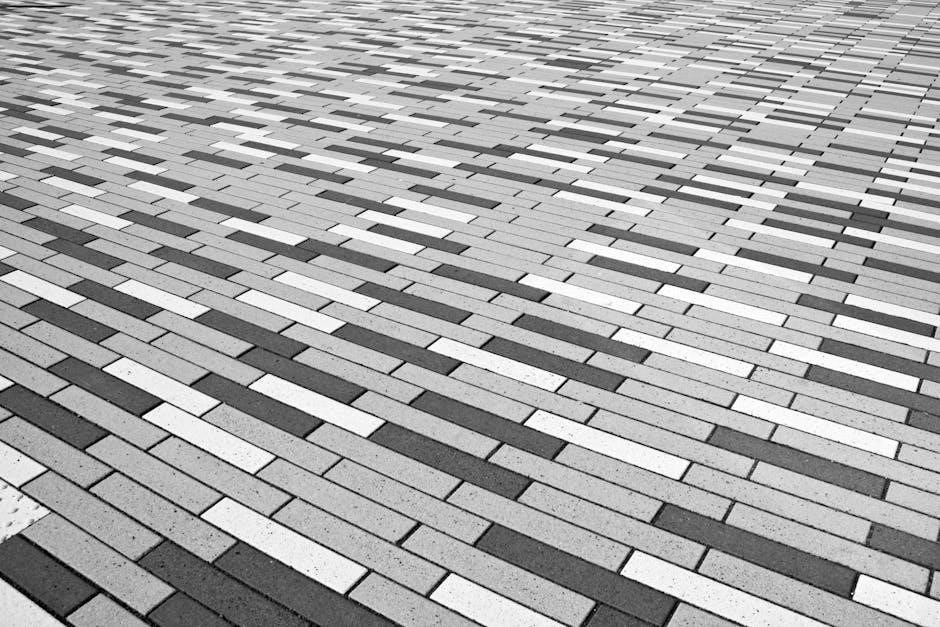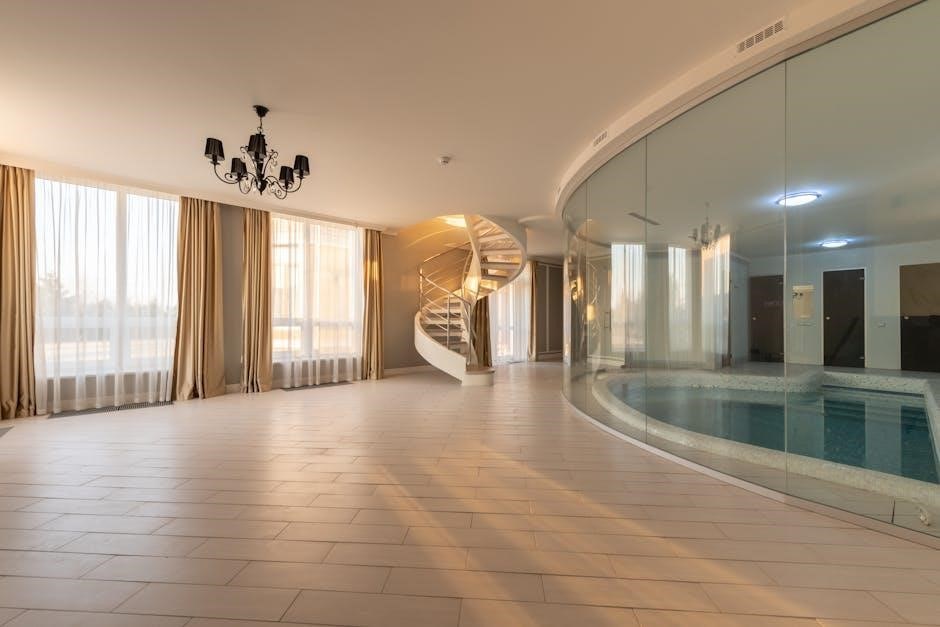Installing an above ground swimming pool is a cost-effective way to enhance your backyard. These pools are durable, easy to maintain, and offer a refreshing escape. Proper installation ensures safety and longevity, requiring careful planning and execution. From site preparation to final touches, each step plays a crucial role in creating a functional and enjoyable swimming experience for years to come.
1.1 Overview of Above Ground Pools
Above ground swimming pools are a popular choice for backyard recreation, offering versatility in size, shape, and material. They are typically made of metal, resin, or hybrid frames, with durable liners to hold water. These pools are known for their affordability, ease of installation, and low maintenance compared to in-ground pools. They come in round, oval, or rectangular designs, making them suitable for various yard sizes and budgets, while providing both aesthetic and functional benefits.
1.2 Importance of Proper Installation
Proper installation of an above ground swimming pool is crucial for ensuring safety, durability, and optimal performance. Incorrect assembly or leveling can lead to structural issues, leaks, or even collapse. A well-installed pool guarantees a stable and secure environment for swimming, while also protecting your investment from premature wear and tear. Ensuring all components are correctly assembled and aligned is essential for long-term enjoyment and reliability of the pool.
Planning and Preparation
Planning and preparation are crucial for a successful above ground pool installation, ensuring compliance with local regulations and selecting the ideal location for safety and optimal enjoyment.
2.1 Choosing the Right Location
Selecting the right location for your above ground pool is essential. Ensure the area is level, well-drained, and receives adequate sunlight. Avoid low-lying spots to prevent water accumulation. Consider wind direction to minimize debris. Keep the pool away from power lines and overhead obstacles. Ensure easy access to electrical and water supplies. Check local regulations for setback requirements and safety guidelines. A well-chosen location enhances safety, functionality, and overall enjoyment of your pool.
2.2 Checking Local Regulations and Permits
Before installing your above ground pool, check local regulations and obtain necessary permits. Zoning laws, building codes, and safety standards vary by area. Ensure compliance with fencing requirements for pool safety. Some regions may require inspections or specific pool placements. Failure to comply could result in fines or installation delays. Always consult local authorities to confirm permit needs and ensure your pool meets all legal requirements.
Site Preparation
Site preparation is crucial for successful pool installation. Clear the area, level the ground, and lay base material to ensure a stable and even surface for your pool.
3.1 Clearing the Area
Clearing the area involves removing debris, vegetation, and obstructions to ensure a smooth installation process. Start by marking the pool location and removing grass or plants within the marked area. Dispose of rocks, branches, and other materials that could interfere with the setup. Check for underground utilities and ensure the site is level and free from obstructions. A clean and clear space is essential for proper pool installation and safety.
3.2 Leveling the Ground
Leveling the ground is a critical step for above ground pool installation. Use a shovel or excavator to create a flat surface, ensuring no uneven areas. Check the ground with a spirit level, adjusting as needed. For larger pools, layer sand or concrete for a stable base. Proper leveling prevents structural issues and ensures the pool sits evenly, allowing it to function correctly and safely. A level surface is essential for a successful installation.
3.3 Laying the Base Material
Laying the base material is essential to protect the pool liner and ensure stability. Spread a layer of sand, compacted concrete, or specialized pool padding evenly across the leveled ground. This prevents sharp objects and uneven surfaces from damaging the liner. Use a rake or trowel for an even distribution and a tamper or roller to compact the material firmly. Properly laid base material ensures a smooth pool surface and extends the pool’s lifespan by preventing damage.
Pool Frame Assembly
Assembling the pool frame requires precision and adherence to manufacturer instructions. Begin by unpacking and organizing all components, ensuring no parts are missing. Follow step-by-step guide to build the frame, starting with the base rails and walls. Secure each section tightly to ensure stability and proper shape, using provided hardware and tools. A well-assembled frame is crucial for the pool’s structural integrity and safety;
4.1 Unpacking and Organizing Components
Unpacking and organizing components is crucial for a smooth installation. Begin by carefully opening all boxes and checking for completeness and damage. Refer to the manual to identify each part, then sort and label them by type. This structured approach ensures every piece is accounted for, preventing delays and ensuring a safe, accurate assembly of your pool frame.
4.2 Assembling the Pool Frame
Assembling the pool frame begins with laying the base and attaching the sides. Follow the manual to connect components securely. Use a wrench to tighten bolts, ensuring stability. Attach the top rails and stabilizer bars to complete the frame. Double-check alignment and levelness to ensure a sturdy structure. Proper assembly is vital for safety and durability, so take your time and follow instructions carefully to avoid any structural issues.

Liner Installation
Install the liner by carefully placing it inside the pool frame, ensuring a smooth, wrinkle-free fit. Secure it tightly to the frame and fill with water.
5.1 Measuring and Cutting the Liner
Measure the pool area to ensure the liner fits perfectly. Remove the top stabilizer rails and hang the liner over the wall, allowing excess material to drape. Smooth wrinkles, stretch the liner snugly, and secure it temporarily. Use a utility knife to trim excess material around the edges, ensuring a precise fit without overhang. This step is crucial for a leak-free and visually appealing installation.
5.2 Attaching the Liner to the Frame
Begin by removing a few top stabilizer rails to access the liner. Carefully drape the liner over the pool wall, ensuring it aligns with the frame. Smooth out wrinkles and stretch the liner snugly, securing it with coping clips or clips provided. Once the liner is tightly fitted, reattach the stabilizer rails to hold it in place. This ensures a secure and even installation, preventing sagging or uneven surfaces.
5.3 Filling the Pool with Water
Start by ensuring the liner is securely attached and free of wrinkles. Place a garden hose in the center of the pool and begin filling slowly. Monitor the water level and liner fit as you fill. Once halfway full, turn on the pool pump to circulate water and check for leaks. Continue filling until the water reaches the recommended level, then test and balance the water chemistry for safe use.
Electrical and Plumbing Connections
Install pool equipment like pumps and filters, ensuring all connections are secure. Connect plumbing lines to the pool and filtration system, testing for leaks. Proper setup ensures safe and efficient water circulation.
6.1 Installing Pool Equipment
Begin by positioning the pump, filter, and heater on a level surface near the pool. Connect hoses to the appropriate ports, ensuring tight seals. Secure all electrical connections according to the manufacturer’s instructions. Test the equipment to ensure proper function and check for leaks. Proper installation of pool equipment is essential for efficient water circulation and maintenance of clean, safe water conditions.
6;2 Setting Up Water Circulation Systems
Connect the pump, filter, and heater with appropriate hoses, ensuring all connections are secure. Prime the pump to prevent dry running. Position skimmer and return jets correctly for optimal water flow. Adjust valves to regulate circulation. Regularly backwash the filter when pressure increases. Ensure electrical connections are safe and meet local codes. Test the system for leaks and proper water circulation before full operation.
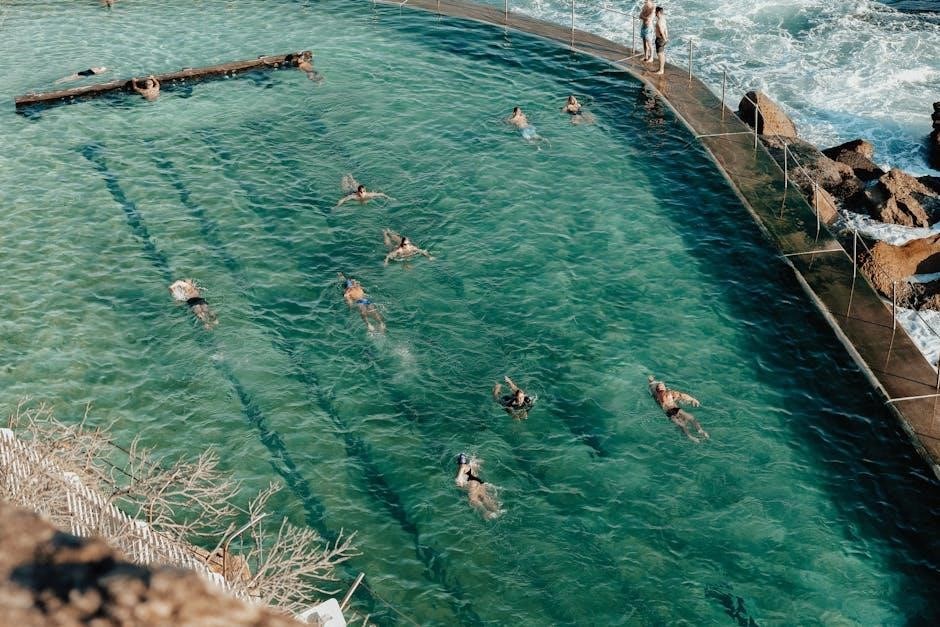
Final Touches
Adding pool accessories and testing water quality ensure a safe and enjoyable swimming experience, completing the installation process effectively.
7.1 Adding Pool Accessories
Enhance your pool experience by adding essential accessories like ladders, handrails, and pool covers. Install skimmer baskets for debris removal and return jets for water circulation. Add lighting for evening use and decorative elements to personalize your space. These accessories improve functionality, safety, and aesthetics, ensuring a complete and enjoyable swimming environment for years to come. Proper installation of these items is key to maximizing their benefits.
7.2 Testing Water Quality
Regularly test your pool water to ensure it is safe and clean. Use test strips or a water testing kit to measure pH, chlorine, and alkalinity levels. Adjust chemicals as needed to maintain proper balance, typically pH between 7.2-7.8 and chlorine levels around 1-3 ppm. Improper levels can cause eye irritation or damage equipment. Test the water at least once a week and after heavy use to maintain optimal conditions for swimmers.
Safety Considerations
Ensure pool safety by installing fencing, gates, and proper lighting. Supervise children and pets near the pool. Regularly inspect equipment and maintain clear emergency plans to prevent accidents.
8.1 Installing Fencing and Gates
Install sturdy fencing and gates around the pool area to prevent unauthorized access, especially for children and pets. Use durable materials like metal or wood, ensuring the fence is at least 4 feet tall. Secure the gate with a latch and consider a self-closing mechanism. Regularly inspect the fencing and gates for stability and proper function to maintain a safe environment around the pool.
8.2 Ensuring Proper Lighting
Proper lighting is essential for safety and ambiance around the pool area. Install energy-efficient LED or solar lights to illuminate walkways and the pool perimeter. Ensure lighting is bright enough for nighttime visibility but not overly harsh. Consider adding timers or motion sensors for automated control. Proper lighting enhances safety, deters intruders, and creates a welcoming atmosphere for evening swims and gatherings, ensuring a secure and enjoyable pool experience.
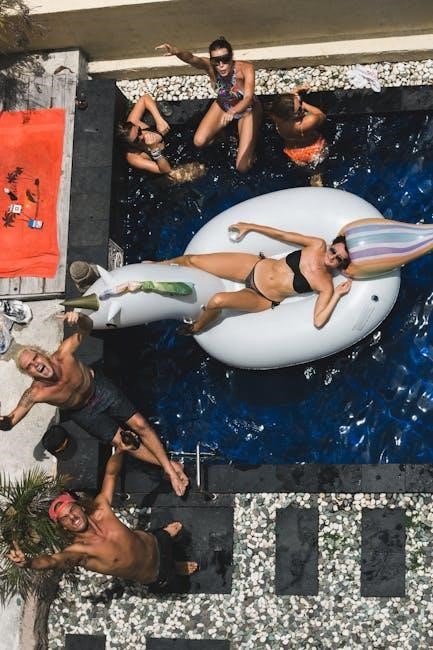
Maintenance and Upkeep
Regular maintenance ensures the pool remains clean, safe, and functional. Schedule routine cleaning, chemical checks, and equipment inspections to maintain water quality and extend pool longevity effectively.
9.1 Regular Cleaning and Chemical Balance
Regular cleaning involves skimming debris, vacuuming the pool floor, and brushing walls to prevent algae buildup. Maintain chemical balance by testing pH and chlorine levels weekly. Adjust levels to ensure safe swimming conditions, usually between 7.2 and 7.8 for pH, and 1-3 ppm for chlorine. Proper chemical balance prevents eye irritation, protects equipment, and maintains clear water quality throughout the season.
9.2 Inspecting Pool Components
Regularly inspect the pool frame, liner, and equipment for signs of wear, rust, or damage. Check the pump, filter, and plumbing connections for leaks or blockages. Ensure all components are functioning properly and replace worn-out parts promptly. This routine maintenance helps prevent major issues, ensuring the pool remains safe and operational for years. Always refer to the manufacturer’s guidelines for specific inspection recommendations.
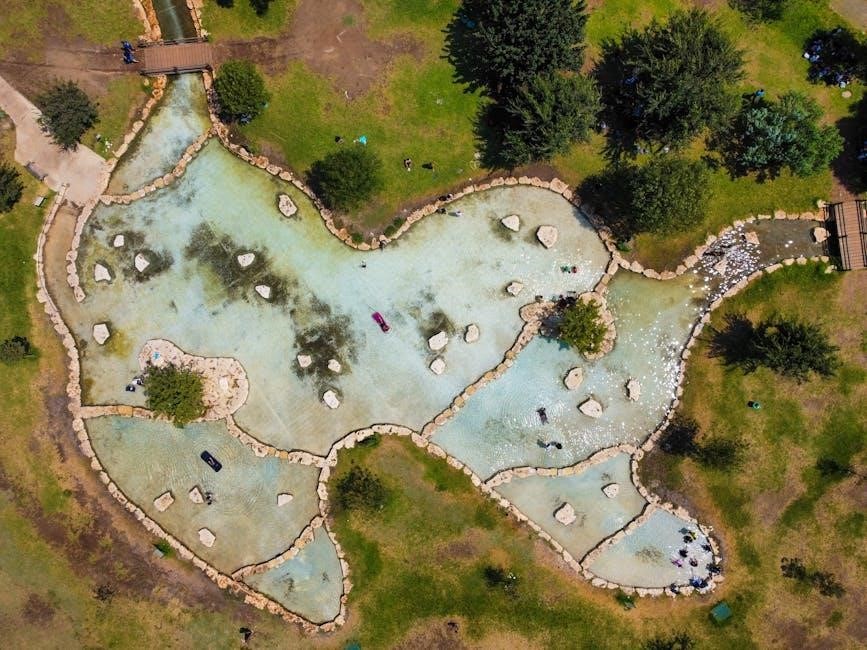
Troubleshooting Common Issues
Identify and address leaks, structural damage, or equipment malfunctions promptly. Check connections, test water circulation, and ensure all components function correctly to maintain pool integrity and safety.
10.1 Identifying Leaks
Leak detection is crucial for maintaining your pool’s integrity. Start by monitoring the water level and checking for unusual drops. Inspect hoses, connections, and pumps for visible cracks or damage. Use food coloring to trace leaks in the pool floor or liner. Addressing leaks promptly prevents further damage and ensures efficient water circulation and chemical balance, safeguarding your pool’s structure and functionality.
10.2 Addressing Structural Damage
Structural damage to your above ground pool, such as rust on metal frames or dents in the wall, requires immediate attention. Inspect the pool’s metal components and liner for signs of wear. Minor dents can be repaired with patch kits, while rust should be treated with a rust-inhibiting coating. For significant damage, consult a professional to prevent further deterioration and ensure the pool’s stability and safety, avoiding costly repairs down the line.

